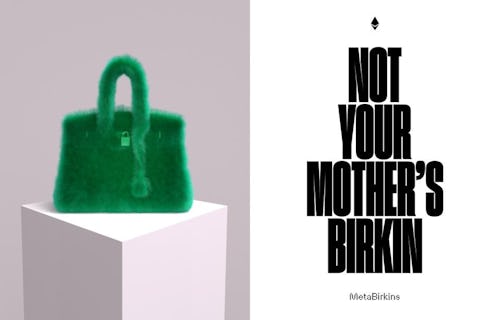
An Hermès lawsuit could soon set a legal precedent for future digital assets like NFTs. After the luxury fashion house sued artist Mason Rothschild in January — alleging he infringed the trademarks of its famous Birkin bag by creating and selling virtual interpretations dubbed “MetaBirkins NFTs” — Rothschild has argued that “MetaBirkins” could be viewed as the title of an art project, not a trademark. His response asks what ownership means in the metaverse and whether NFTs can qualify as artistic expression, two questions that could impact brands eager to protect their intellectual property in web3.
Rothschild’s MetaBirkins boast the same look as their real-life counterparts, although the digital versions are covered with fake fur. Disclaimers on Rothschild’s website clarify that the blockchain-based bags are not associated with Hermès — although that doesn’t seem to be enough for the luxury label, which is notoriously defensive of its Birkin bags. Tangible versions of the bag are best known for their scarcity, although that meaning changes within the metaverse, where scarcity is created artificially.
What’s protected (and what’s not) —
Rebecca Tushnet, a Harvard Law School professor representing Rothschild, has argued the term MetaBirkins is the title of a digital art project that provides commentary on the relationship between consumerism and the value of art — meaning the NFTs are therefore protected by the First Amendment. According to Tushnet, the MetaBirkins NFTs are also protected under the Second Circuit’s Rogers v. Grimaldi test, a 1989 ruling that established users of a trademark would be shielded from infringement claims if their use is an artistic expression that doesn’t explicitly mislead consumers. The latter ruling has been used to bolster a motion to dismiss the case, according to Bloomberg Law, establishing that a “slight risk” of consumer confusion is outweighed by “the danger of restricting artistic expression.”

Hermès attorney Oren Warshavsky, however, says that by using the MetaBirkins name to identify his product, Rothschild is leading consumers to incorrectly believe the NFTs are connected to Hermès. Another confusing factor, Warshavsky notes, is that neither party has clearly established what an NFT is or what it represents.
Impacting future NFT art —
Labeling the MetaBirkins as art could have an impact on future legal battles surrounding intellectual property and NFTs: Per Bloomberg Law, Tushnet says any legal result other than a dismissal will have a “chilling effect” on artists who want to depict famous brands but don’t have the money for a successful legal defense. On the other hand, dismissing the case would set a legal precedent for other brands looking to protect their intellectual property in the metaverse, allowing people to use trademarks freely so long as the digital projects were considered art.

Warshavsky says the Rogers test doesn’t apply — Rothschild set up an online store, webpage, Twitter, and Instagram handle all with the MetaBirkin name, with the intent of selling digital goods. The attorney added that reported stories point to actual consumer confusion, meaning Rothschild’s NFTs can’t be protected from infringement claims. To that, Tushnet cited the Rogers test, saying that an expressive work like the MetaBirkins is different from ordinary consumer products.
Bottom line —
Much of the legal battle comes down to defining what NFTs are and aren’t. If they’re art (or expressive works, as Tushnet puts it), the MetaBirkins and similar future projects can be protected. If NFTs are products, any digital collectible involving a trademark will be liable for intellectual property lawsuits.
NFTs can’t be eliminated from the blockchain, meaning that even if Hermès wins, there are limited options for the brand to get rid of Rothschild’s MetaBirkins. The closest alternative, according to Surface, is “burning,” which transfers the NFT — its record of sale, not the image itself — to an inaccessible wallet. This would (unintentionally) create a black market NFT, generating another slew of questions — the most important one being, when will this end?







